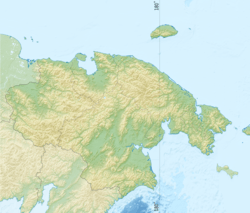Lake Elgygytgyn
| Elgygytgyn Lake | |
|---|---|
 View of the lake | |
 Elgygytgyn Lake Location in Chukotka, Russia | |
| Location | Chukchi Peninsula, northeast Siberia |
| Coordinates | 67°30′N 172°00′E / 67.500°N 172.000°ECoordinates: 67°30′N 172°00′E / 67.500°N 172.000°E |
| Type | Impact crater lake, oligotrophic |
| Primary outflows | Enmyvaam |
| Catchment area | 293 km2 (113 sq mi) |
| Basin countries | Russia |
| Max. length | 12 km (7.5 mi) |
| Max. width | 12 km (7.5 mi) |
| Surface area | 110 km2 (42 sq mi) |
Lake El'gygytgyn (Russian and Chukchi: Эльгыгытгын) is an impact crater lake located in the Chukotka Autonomous Okrug in northeast Siberia, about 150 km (93 mi) southeast of Chaunskaya Bay.
The word "Elgygytgyn" means "white lake" in the Chukchi language.
The lake is of particular interest to scientists because it has never been covered by glaciers. This has allowed the uninterrupted build-up of 400 m (1,300 ft) of sediment at the bottom of the lake, recording information on prehistoric climate change.
Geography
Lake El'gygytgyn is drained to the southeast by the Enmybaam branch of the Belaya River. It is approximately 12 km (7 mi) in diameter and has a maximum depth of 174 ± 2 m (571 ± 7 ft). The lake is centered within an impact crater with a rim diameter of 18 km (11 mi) that formed 3.6 million years ago during the Pliocene.[1] Before it was reliably dated, preliminary papers in the late 1970s suggested either Elgygytgyn[2] or Zhamanshin[3] as the source of the Australasian strewnfield.
 Location of El'gygytgyn Lake |
 Landsat 7 satellite image of the lake |
Scientific drilling
In late 2008 and early 2009, an international team from Germany, Russia and the USA conducted a drilling program targeting three holes in Elgygytgyn Lake. The resulting cores are designated ICPD Site 5011-1 and 5011-3.[4] This co-sponsored by the International Continental Scientific Drilling Program (ICDP), with funding also provided by the U.S. National Science Foundation (NSF), the German Federal Ministry of Education and Research (BMBF), Alfred Wegener Institute (AWI) and GeoForschungsZentrum Potsdam (GFZ), the Russian Academy of Sciences Far East Branch (RAS FEB), the Russian Foundation for Basic Research (RFBR), and the Austrian Federal Ministry of Science and Research (BMWF).[4]
Fauna
The conditions in the El'gygytgyn lake are extremely severe for fish life. Even so, there are three species permanently inhabiting the lake's harsh aquatic environment.[5] These are three types of char: Salvelinus boganidae, S. elgyticus (Small-mouth char) and Salvethymus svetovidovi (long-finned char).[6] The two latter species are endemic to the El'gygytgyn lake. The golets (Salvelinus alpinus, Russian: голец) has been introduced recently. Fish species in the lake are adapted to its very cold waters, which are generally just above the freezing point, and spend most of the year in total darkness. The surface is frozen for about 10 months of the year. It may start to melt in the summer, but some years it never fully thaws.[7]
See also
References
- ↑ "El'gygytgyn". Earth Impact Database. University of New Brunswick. Retrieved 2009-08-19.
- ↑ R.S. Dietz (1977), Elgygytgyn Crater, Siberia: Probable Source Of Australasian Tektite Field Meteoritics, June 1977, Vol 12, Issue 2, p. 145–157
- ↑ B.P. Glass (1979), Zhamanshin crater, a possible source of Australasian tektites? Geology, July 1979, v. 7, p. 351-353
- 1 2 Melles; et al. (2011). "The Lake El’gygytgyn Scientific Drilling Project – Conquering Arctic Challenges through Continental Drilling" (PDF). Scientific Drilling (10). doi:10.2204/iodp.sd.11.03.2011. Retrieved 2 December 2015.
- ↑ Fly Fishing Russia – The Elgygytgyn Lake, Chukotka
- ↑ Salvethymus svetovidovi
- ↑ Arctic char (Salvelinus alpinus) in the lake
External links
- Dr. Matt Nolan at the University of Alaska Fairbanks
- Polar Expedition to Siberian Lake will Yield Details of Past Climate PhysOrg.com.
- NASA Earth Observatory
- Haltia E. M., Nowaczyk N. R. Magnetostratigraphy of sediments from Lake El’gygytgyn ICDP Site 5011-1: paleomagnetic age constraints for the longest paleoclimate record from the continental Arctic, 2014.

